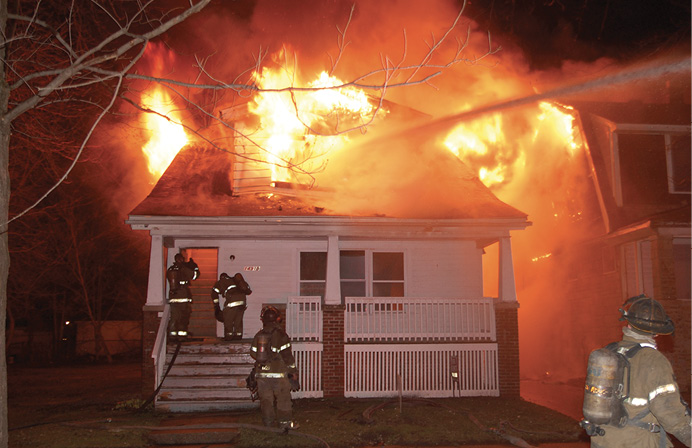
On the fireground, time is not ours to waste. We must identify our searchable spaces immediately! We can employ multiple methods to enhance the survivability of unprotected occupants. We will be operating in places that are occupied by civilians, so how we search matters. It is the expectation that we will perform in an aggressive and effective manner.
When you first arrive on scene, some vital information to know includes the following: Where can we search? What will be the best way to effect our search? How can we increase our odds to not only locate victims but remove them in the most efficient manner?
Let us not forget that life is and always will be our number one priority! It should never be a firefighter’s mindset to focus on “what’s good for us” but rather to concentrate our efforts on what is best for the civilians!
RELATED FIREFIGHTER TRAINING
Search and Rescue by the Numbers
Gather Information
The use of a 360° walk-around in relation to performing searches is something that we cannot discount. Performing a 360 is not just used to develop tactics to combat the fire based on its conditions; it is also a way to gather information for the big picture and to prioritize our assignments. It allows us to use our resources more effectively, as there is nothing definite when it comes to where we will find victims.
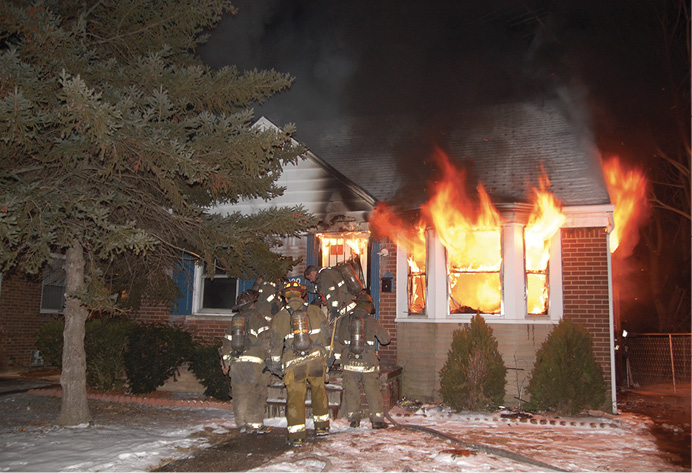
(1) There is likely to be a good amount of searchable space within this structure. The fire will not take a time out while searches are being made. Having an attack team suppress the fire and support the search effort is of greatest benefit in this scenario given the staffing available. (Photos 1-3 by Dennis Walus.)

(2) An exterior stream is placed into operation to start attacking the fire and improve conditions while firefighters are preparing for entry.
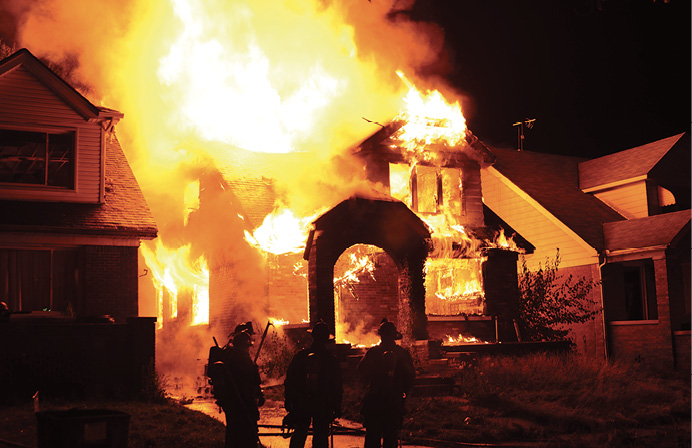
(3) When giving your size-up to incoming units, this is what “fully involved” should indicate, as it is what’s most likely envisioned once heard. This can cause a slowdown of urgency or a misconception that there is no searchable space left in the structure, which may not be entirely true.
Aside from sizing up the fire, gathering information for potential trapped occupants can aid in the search. Some important information to gather includes victims’ ages, which rooms they usually are in, and their names. Because time is the enemy, this should not be a full conversation but can be ascertained while masking up.
When the last known location of the victim is reported, search efforts should start in that area immediately. If you are dealing with the entrapment of a child or disabled person, do not forget that depending on age or ability, these victims cannot move.
Starting your search from the front door and hugging every square inch of the wall does a tremendous disservice to the victim and wastes valuable time that could be spent clearing high-probability areas. With the first four minutes on scene accounting for more than 60 percent (based on data accumulated from 1,172 recorded rescues) of victims’ survival rate, having a system in place to aid in our decision making is crucial.
Identifying searchable spaces immediately on our 360 is essential. One way we can do this is by using a method described as “BAG” the fire. The purpose of this tactic is to know where the fire has been, where it is now, and where it is projected to go.
Mindful that everything is searchable at some point, we need to prioritize our areas to target search and work to finish the primary search of the structure from there. If we don’t, we will surely lose it along with anyone potentially in those areas.
When deciding where to start our searches, the smoke’s color, volume, velocity, and density in relation to the point of entry when initiating a search should guide your decision-making process. When we make entry at any point in the structure—whether through a door or window—flow paths change. Flow paths go from high pressure to low pressure, and if we create multiple flow paths, this will cause the fire to grow and temperatures to increase. If we are not cautious and do not control the flow path, it will impact our safety as well as the survivability of anyone within the structure. From victims’ standpoint, being in the exhaust of the flow path reduces their potential survival time.
Simply put, if we wish to “slow” the fire down and improve conditions for survivability, we must interrupt either the flow path’s inlet or exhaust point. This can be accomplished in a multitude of ways; choose the best tactics given your situation, and know what kind of impact they may have on the fire environment as well as on trapped occupants. An effective means to accomplish this may be by quickly applying water to the fire through a window or doorway. By doing so, you return the fire to a fuel-limited stage, which helps support the search effort. This tactic is just one of many but, when properly executed, it has tremendous benefits to everyone and increases the time you are able to operate during your search.
According to the Federal Emergency Management Agency and the U.S Fire Administration in a publication on civilian fire fatalities in residential buildings, burns and smoke inhalation combined accounted for 48 percent of the fatalities. Smoke inhalation accounted for 37 percent of residential fire fatalities, and thermal burns accounted for 6 percent of fatalities.
Statistics such as these stress the need for fire departments to recognize where their greatest opportunity for victim survivability is in modern residential structure fires. For fire departments to maximize occupant survivability within structure fires, it is essential to adapt scientifically backed methods for development and implementation of rapid, properly placed, and professionally executed searches along with skillful interior and exterior fire attack tactics.
A key component we should analyze is the location of the fire and its severity in relation to victim location. In recent studies performed by Underwriters Laboratories (UL), it was found that exposure duration is a factor as important as, if not more important than, dose. So, what does that mean for us? Even though searchable spaces may exist at the time of our arrival, the survivability potential of occupants decreases as the time of exposure increases.
Because there is a chance the occupant can survive in the searchable spaces identified, the number one priority of arriving crews should be rescue. This is not to advocate that we should not perform other crucial tasks. Immediate intervention involving suppression and ventilation is necessary to increase the survivability of all spaces in the structure. However, we should take what we analyzed of the scene on arrival and during our 360 and perform a risk vs. benefit analysis of the situation.
“If a victim can survive the environment, risking crews on an interior search prior to fire control is of greater benefit than if no survivable spaces exist.”
—UL, “Tactical Considerations: There Can Be Survivable Spaces Upon Arrival”
In relation to our victims’ odds of surviving the fire environment, we need to consider the effect of Fractional Effective Dose (FED) and what it means for our trapped occupants. Both temperature and toxic gas exposures play a vital role here.
FED is equal to the dose received in a given time divided by the effective dose required for a specified endpoint, such as incapacitation or death. The higher the FED, the less chance of survivability; the lower the FED, the higher chance that a victim could survive the environment. The earlier into an incident that our victims are removed from the structure, the less toxic exposure they will receive, ultimately increasing their chances for survival.
Time Matters
Remember, the first step in removing our victims is for us to locate them. For that reason, our searches must start as soon as possible.
So, we need to be asking ourselves, what is an acceptable delay before we enter the space to get these victims out? Understand that time matters! How quickly we turn out matters; our mask-up time matters.
We should be masking up with gloves on in less than 20 seconds, but, optimally, we will do so within 10 to 15 seconds. How efficiently we stretch a line and place it in operation matters, how we perform and how quickly we start ventilation matters, the order in which tasks are assigned and using our personnel wisely matter—everything we do matters! Seconds add up to minutes, and those minutes do not belong to us; they belong to the victims!
Fact-Based Decision Making
It is important that we relay accurate information that we gathered during the 360 to the incoming units. Our words are powerful and set the stage for everyone else responding to the scene. Do not paint a picture that may cause them to move with less urgency when they arrive.
Fully involved should mean the whole structure is engulfed, not 25 percent, 50 percent, or 75 percent. If we are unsure of the estimate, stating “heavy fire and smoke showing from two rooms, three rooms,” and so on would be a better statement than fully involved. We do not want to discount searchable spaces because of a lack of understanding of what the fire is doing because it is easier on us.

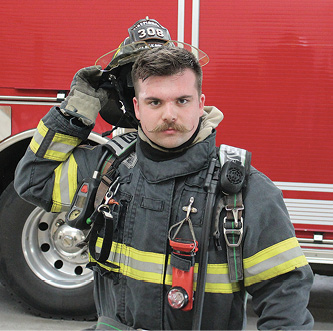
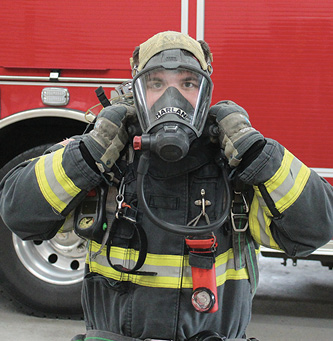
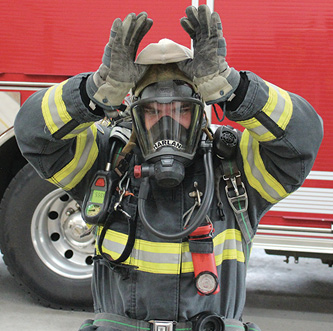
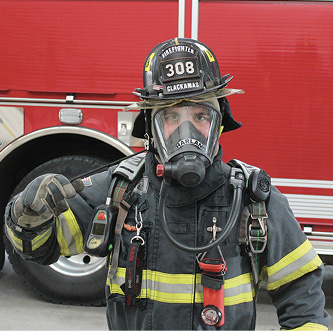
(4-8) How to perform masking up with gloves on in less than 10 seconds. (Photos 4-8 courtesy of Matthew Harlan.)
“Whatever you decide on your evaluation of the spaces, you will live with the consequences of your decisions for the rest of your life.”
—Mike Gagliano, “The Art of Go/No-Go: Fireground Decision Making”
Although we have a tremendous amount of data available to us about survivable spaces, we must remember that many things factor into the victim’s survivability, and there are different views on how we should approach the size-up for searches. Some use the term “survivability profiling”; others use “searchable/not searchable” or “tenable space.” In reality, whichever term you use, make sure you understand what it means and be sure your resources are being directed in the most effective manner.
RELATED FIREFIGHTER TRAINING
High-Target Areas for the Residential Primary Search
Fact-based decision making is what we are after, not fear-based. If there are no facts, then what you have is fiction, and fiction means it does not exist. So, if that is the case, we have a great potential for critical decisions to be made based on perceptions of reality. If we choose to write something off based on the opinion that there is no way someone can survive the environment, we are not performing the duties our civilians were promised, expect, and pay for. As stated previously, everything is searchable at some point, but we have to analyze our approach and direct search efforts into spaces that we can survive with our bunker gear. If we can’t operate in it, odds are victims can’t survive it.
We have learned that victims’ locations relative to the fire and their elevation within the space make a difference. Choosing actions that improve conditions within the structure could turn what initially appears to be a nonsurvivable space into a potentially viable one. If we dismiss this by misunderstanding or misusing terminology, then we are not giving them the best chance at survival.
We are currently preaching the “Close Before You Doze” campaign. We are telling our citizens to close the door because it can save their life. We are giving them the assumption that we will be coming for them. Let us not be hypocrites. If we truly believe that closed doors are open opportunities, then we owe it to them to make every effort to occupy the interior and search those spaces!
Civilian lives depend on us to decrease our time to locate and remove them; that has been proven. So, if we can search it, we make entry. Let’s not give up on them unless it’s impossible for us to get to them.
It is easy for us to be so consumed with the obvious visible problems that it can cause us to discount the need to put emphasis on the potential victims trapped by fire! We need to be intelligently aggressive and make our decisions based on a solid foundation of core knowledge. This allows us to be aggressive with our searches and make educated decisions with proven tactics that can be backed with real-world data.
For example, let’s revisit why we advocate closing doors at night. The UL study “Occupant Tenability in Single Family Homes: Part I—Impact of Structure Type, Fire Location and Interior Doors Prior to Fire Department Arrival” states: “While interior residential doors are not designed specifically as a fire protection system, the ability for such doors to provide temporary protection is important to quantify.”
This study is important to us when it comes to searching because UL has provided proof through its studies that a closed door makes life-saving differences in a fire. Temperatures behind the door decreased by nearly 900°F, providing a more survivable temperature. When we consider that the human airway fails when exposed to 185°F of heat for more than 20 seconds, ultimately causing death, this reduction in temperature is of tremendous benefit to our victims.
Oxygen levels were proven to be of higher concentrations of 18 percent, which can support life. If the victim is isolated from the fire, there will be a decreased amount of oxygen available to the fire area, decreasing heat release rates. As the fire growth slows, there is reduced smoke inside that room, which means less toxic carbon monoxide levels. All these things add to the increased survivability rate of the trapped occupants.
During extensive tests, it was discovered that with the bedroom door open, the victim would have exceeded survivability thresholds at approximately 7 minutes because of toxic gases and 9 minutes because of heat flux. With the bedroom door closed, the victim remained well below the survivability thresholds throughout fire extinguishment. When we are searching and enter a room, we want to close the door behind us. This isolates us from the fire, causing smoke to lift and temperatures to decrease, which improves our conditions for the search.
Another consideration during search is to ventilate the room by taking a window. During the Fire Department of New York’s Governors Island study, the National Institute of Standards and Technology and UL discovered that ventilating windows in rooms with closed doors has little to no impact on conditions within the structure because it is isolated from the fire (flow path). This buys you and victims time!
One great resource is www.firefighterrescuesurvey.com. This Web site tracks data that has been submitted from all over the country and allows us to understand our rescues, but it includes successes and failures. Having this information allows us to focus our efforts on the areas in which we have the greatest chance of finding victims. For example, during the last evaluation of rescue data, it was found that from the hours of 2100 to 2259, the hallway is the number one location for victims; 18 out of 24 hours a day, bedrooms are the number one location for victims. Why is this important to know? By using the knowledge we have, we can reduce the time it takes to locate and remove these victims; therefore, we are winning.
Have a Search Plan
Search crews remaining oriented within the structure are where our successes lie. Currently, with the data that has been collected, it is estimated that nearly 58 percent of our victims who were found during a primary search had a 57 percent survival rate.
There must be a plan when implementing a search. If you do not have one, the experience will most likely end in confusion and impede the search. Just as a teacher develops a lesson plan to make sure to cover all information, we need a search plan. Without it, we will be searching blindly and are sure to miss something. The data collected about the likely whereabouts of our victims helps us to be able to target and prioritize our searches.
Another way to improve our search plan is by knowing the first due and building layouts. Pay attention to floor plans in your response area. Newer homes tend to have large, open floor plans, and we often find that the master bedroom is away from the general location of the children’s rooms. During your search, if you find one family member, there are likely to be more close by or within arm’s reach. This is especially true with parents and children. Performing your 360 sweep around a victim you find is imperative because parents will try to locate their children and children will try to seek out their parents. When siblings are involved, they will most likely be trying to find one another.
Professional athletes spend countless hours studying their opponents, training, and knowing the arenas in which they perform. We, as firefighters, should be doing the same. We need to be preparing ourselves to win. We have to be able to search with confidence and search as if we are searching for our own family. Our goal is to look for viable victims in obvious places.
No one is asking you to do something that you are not qualified to do. Do not have the mindset of “I will rise to the level of expectation.” This will surely end in failure. Instead, have the mindset of “I will only fall to the level of my training.”
Successful rescues are made not just by mere chance; they happen as the result of properly executed searches because of the amount of preparation and dedication that the searchers involved have put forth. Expect victims at every fire, and establish and maintain an aggressive but educated search culture. They expect no less!
References
Zevotek, R., Stakes, K. and Willi, J. “Impact of Fire Attack Utilizing Interior and Exterior Streams on Firefighter Safety and Occupant Survival: Full Scale Experiments.” Underwriters Laboratories Firefighter Safety Research Institute. January 2018.
www.firefighterrescuesurvery.com.
https://ulfirefightersafety.org/research-projects/governors-island-experiments.html.
National Fire Data Center.
https://www.usfa.fema.gov/data/statistics/.
https://www.usfa.fema.gov/downloads/pdf/statistics/v18i4.pdf.
Tracheal Burning from Hot Air Inhalation. Christina Cossel, Jan Ma, Samantha Spindel, Yang Wang. Cornell University, Ithaca NY. May 4, 2007.
Zach Bruhn, Precision Fire Service Consulting LLC. “Impact of Fire Attack Utilizing Interior and Exterior Streams on Firefighter Safety and Occupant Survivability: Parts: I, II, & III Summary Presentation.”
SEAN DUFFY is a 15-year veteran of the fire service and a firefighter/paramedic for the Venice (FL) Fire Department. He is a co-founder of “Build Your Culture LLC” training group and developed the courses “Searchable vs. Survivable—Educated Decision Making on the Fireground” and “Build Your Culture— Professionalism or Minimalism?” He has an associate degree in fire science and is a State of Florida fire instructor, fire officer 1, and live fire training instructor. He is an active member of the Marion County F.O.O.L.S. (McFools) and has instructed at several fire conferences throughout the country.

